
The ERL KLIA Ekspres is an express airport rail link servicing the Kuala Lumpur International Airport (KLIA) in Malaysia. It runs from KL Sentral, the main railway station of Kuala Lumpur to KLIA as well as its low-cost terminal, klia2. The line is one of the two services on the Express Rail Link (ERL) system, sharing the same tracks as the KLIA Transit. The KLIA Transit stops at all stations along the line, whereas the KLIA Ekspres runs as a direct non-stop express service between KL Sentral and KLIA/klia2. The is operated by Express Rail Link Sdn. Bhd. (ERL).

The Mass Transit Railway (MTR) is a major public transport network serving Hong Kong. Operated by the MTR Corporation Limited (MTRCL), it consists of heavy rail, light rail, and feeder bus service centred on a 10-line rapid transit network serving the urbanised areas of Hong Kong Island, Kowloon, and the New Territories. The system included 240.6 km (149.5 mi) of rail as of 2022 with 167 stations, including 98 heavy rail stations, 68 light rail stops and one high-speed rail terminus.

A metro station or subway station is a train station for a rapid transit system, which as a whole is usually called a "metro" or "subway". A station provides a means for passengers to purchase tickets, board trains, and evacuate the system in the case of an emergency. In the United Kingdom, they are known as underground stations, most commonly used in reference to the London Underground.
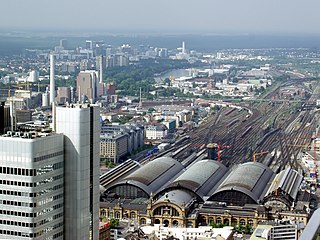
The public transit system in Frankfurt is part of the Rhein-Main-Verkehrsverbund transport network and consists of several carriers who all use the same fare system. Therefore, one ticket is valid for a journey which may include several modes of transit run by different operators. The fares are paid in advance of travel at a ticket vending machine or at the driver on board a bus. There are no turnstiles or other controlling barriers; instead, a proof-of-payment system is used. Plainclothes fare inspectors are employed and carry out random checks to ensure passengers have paid. If found to be travelling without a ticket, then they are required to pay a fine of €60. A single way trip within Frankfurt costs between €1.80 and €2.80, and a journey to the suburbs outside Frankfurt costs between €4.65 and €9.10 approx. There are also some discounts for children for groups or day tickets. A day ticket for traveling within Frankfurt costs €7.

The Airport Express is one of the ten lines of the Hong Kong MTR system. It links the urban area with the Hong Kong International Airport and the AsiaWorld–Expo exhibition and convention centre.
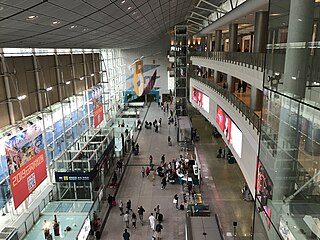
Hong Kong is a station of the MTR metro system in Hong Kong. It is the eastern terminus of the Tung Chung line and Airport Express. It is situated between Man Cheung Street and Harbour View Street, Central, Hong Kong Island, and sits underneath the International Finance Centre (IFC). It opened on 22 June 1998.

Lo Wu is the northern terminus of the East Rail line of Hong Kong, located in Lo Wu within the Closed Area on Hong Kong's northern frontier. The station serves as a primary checkpoint for rail passengers between Hong Kong and mainland China and vice versa, rather than serving a specific area. It is also the northernmost railway station in Hong Kong.

Intermodal passenger transport, also called mixed-mode commuting, involves using two or more modes of transportation in a journey. Mixed-mode commuting is often used to combine the strengths of various transportation options. A major goal of modern intermodal passenger transport is to reduce dependence on the automobile as the major mode of ground transportation and increase use of public transport. To assist the traveller, various intermodal journey planners such as Rome2rio and Google Transit have been devised to help travellers plan and schedule their journey.
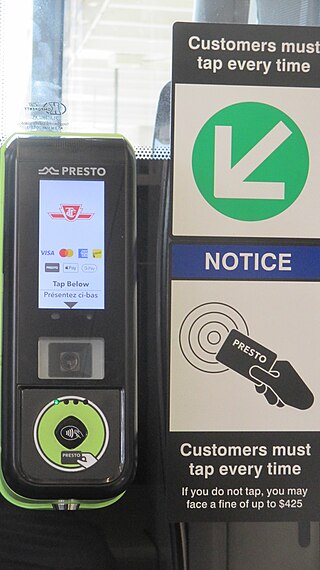
Fares to use the Toronto Transit Commission (TTC) transit system in Toronto, Ontario, Canada, can be paid with various media. The price of fares varies according to age, occupation, income level, and health condition of riders.
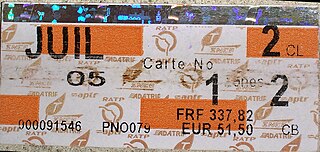
The carte orange was a pass for the public transportation system in Paris and the surrounding Île-de-France region. A holder of the pass was entitled to unlimited use of the public transit system within a given period of time, with Cartes oranges being available for durations of one week or one month. The carte orange was discontinued in February 2009, and replaced by Navigo semaine and Navigo mois on a Navigo card.

Proof-of-payment(POP) or proof-of-fare(POF) is an honor-based fare collection system used on many public transportation systems. Instead of checking each passenger as they enter a fare control zone, passengers are required to carry a paper ticket, transit pass, transit smartcard - or open payment methods such as contactless credit or debit cards (if applicable) - after swiping or tapping on smart card readers, to prove that they have paid the valid fare. Fares are enforced via random spot-checks by inspectors such as conductors or enforcement officers, to ensure that passengers have paid their fares and are not committing fare evasion. On many systems, a passenger can purchase a single-use ticket or multi-use pass at any time in advance, but must insert the ticket or pass into a validation machine immediately before use. Validation machines in stations or on board vehicles time stamp the ticket. The ticket is then valid for some period of time after the stamped time.
Revenue protection inspector (RPI) or revenue protection officer (RPO) is the job title given to staff who patrol different forms of public transport issuing penalty fares to passengers who travel without a valid ticket or without the correct ticket.

The fares for services operated under the brands of MTA Regional Bus, New York City Subway, Staten Island Railway (SIR), PATH, Roosevelt Island Tramway, AirTrain JFK, NYC Ferry, and the suburban bus operators Nassau Inter-County Express (NICE) and Westchester County Bee-Line System (Bee-Line) are listed below.
Fare avoidance, as distinct from fare evasion, is the lawful use of knowledge to travel using tickets which cost significantly less than the 'normal' fare for a given journey, which is what one might be expected to use. It is common in some parts of the world with complex travel networks, notably the National Rail network of Great Britain.
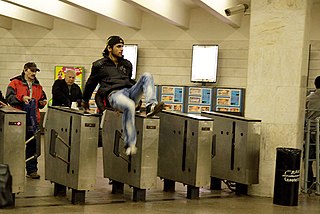
Fare evasion or fare dodging, fare violation, rarely called ticket evasion, is the act of travelling on public transport without paying by deliberately not buying a required ticket to travel. It is considered a problem in many parts of the world, and revenue protection officers and ticket barriers, staffed or automatic, are in place to ensure only those with valid tickets may access the transport. The term fare avoidance is sometimes used as a euphemistic synonym and sometimes used to refer to the lawful use of much cheaper tickets.

The Beijing–Kowloon through train was an intercity railway service between Hung Hom station in Hong Kong and the Beijing West railway station in China, jointly operated by the MTRC of Hong Kong and China Railway, China's national rail service. The train ran to Beijing and Hong Kong every other day. Services used the East Rail line in Hong Kong, crossed the boundary between Hong Kong and mainland China at Lo Wu and then continued along China's railway network via the Guangshen railway and the Jingguang railway to Beijing. Total journey time was approximately 23 hours, and the train uses 25T class train carriages.
A penalty fare, standard fare, or fixed penalty notice is a special, usually higher, fare charged because a passenger using public transport did not comply with the normal ticket purchasing rules. It should not be confused with an unpaid fares notice.
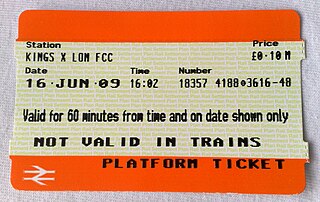
A platform ticket is a type of rail ticket issued by some railway systems, permitting the bearer to access the platforms of a railway station, but not to board and use any train services. It allows non-passengers to enter the paid area of the station, for example to walk with their friends, associates and loved ones all the way to the passenger car at stations where the general public is not admitted to platforms. Trainspotters can also purchase platform tickets and enjoy their trainspotting hobbies. They vary in type: some may only allow limited access and a sharply limited time of usage, while others may have totally free access to enter the platform area. During peak usage hours or rush hours, the platforms may only be available for passengers who intend to travel.
GO Transit is the inter-regional transportation authority of the Golden Horseshoe, which includes the Greater Toronto and Hamilton Area. It is Canada's oldest regional transit system, first serving passengers in 1967.
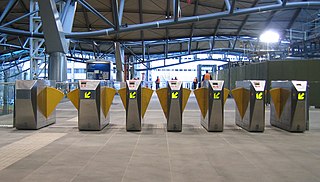
An automated fare collection (AFC) system is the collection of components that automate the ticketing system of a public transportation network - an automated version of manual fare collection. An AFC system is usually the basis for integrated ticketing.

















